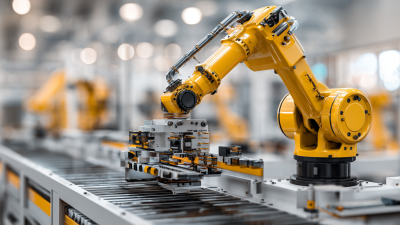What is Automated Machine Learning Its Impact on Industry Growth and Efficiency
As we enter an era marked by rapid technological advancements, the concept of automated machine learning is increasingly coming to the forefront. Automated machine learning refers to the process of automating the end-to-end process of applying machine learning to real-world problems. By minimizing the need for human intervention, this approach allows businesses to accelerate their data analysis capabilities, leading to more informed decision-making and enhanced operational efficiency.
The impact of automated machine learning on industry growth is profound, shaping how organizations across various sectors harness data-driven insights. Companies are now leveraging these tools to not only improve their workflows but also to innovate products and services more swiftly than ever before. The streamlined processes provided by automated machine learning enable firms to allocate resources more effectively, thereby optimizing output while reducing errors and time spent on mundane tasks.
Looking towards 2025, the integration of automated machine learning is poised to revolutionize industries, fostering a competitive edge for those who adopt this technology early on. As organizations become more adept at utilizing automated machine solutions, we expect to see a significant transformation in productivity and efficiency, ultimately reshaping the landscape of business operations.

Understanding Automated Machine Learning and Its Functionality
Automated Machine Learning (AutoML) is a powerful framework designed to simplify the machine learning process. By automating routine tasks such as model selection, hyperparameter tuning, and feature engineering, AutoML allows even those with limited expertise to develop effective machine learning models. This functionality is achieved through algorithms that explore multiple models and their configurations, thereby identifying the best performing solutions for specific datasets.
The impact of AutoML on industry growth is profound, as it significantly reduces the time and resources traditionally required for machine learning projects. Companies can now deploy models quickly and efficiently, leading to faster decision-making and improved operational efficiency. Furthermore, as AutoML democratizes access to sophisticated analytics, businesses of all sizes can leverage predictive insights, ultimately fostering innovation and enhancing competitiveness across various sectors.
Key Industries Benefiting from Automated Machine Learning in 2025
Automated Machine Learning (AutoML) is set to play a pivotal role in transforming various industries by leveraging AI technologies to enhance efficiency and drive growth. By 2025, the Japanese artificial intelligence market is projected to expand from $15.64 billion to an astonishing $123.9 billion by 2032, showcasing a remarkable compound annual growth rate of 34.40%. This rapid growth underscores the increasing adoption of AI-driven solutions across sectors, particularly in financial services and manufacturing.
The financial industry, which is rapidly digitizing, is particularly benefitting from AI-powered automated testing platforms. These platforms ensure software quality by enhancing the stability and security of financial systems, a critical factor for operations and user trust. Furthermore, the manufacturing sector is embracing digital twin technologies that improve precision through advanced modeling and design, significantly optimizing manufacturing processes. As these industries harness the potential of AutoML, they are poised to redefine their operational frameworks, streamline processes, and ultimately solidify their competitive edges in the market.

Impact of Automated Machine Learning on Business Efficiency and Performance
Automated Machine Learning (AutoML) is transforming the landscape of business efficiency and performance across various industries. According to a report from Gartner, by 2025, 70% of reusable data science and machine learning models will be built via AutoML platforms, signifying a shift towards streamlined processes that enhance productivity. This technology minimizes the need for extensive programming knowledge, allowing businesses to harness the power of data analytics without requiring specialized data scientists. As companies increasingly adopt AutoML, improvements in operational efficiency have been reported, with many experiencing cost reductions of up to 30% in data processing tasks.
Tips: To maximize the benefits of AutoML, organizations should invest in training sessions for their employees. Ensuring that staff are familiar with AutoML tools can lead to quicker implementation and better overall results. Furthermore, integrating AutoML with existing systems is vital for seamless data flow and analysis.
Research from McKinsey has shown that businesses utilizing AutoML report a 50% increase in productivity in data analysis tasks. This technological advancement not only speeds up the decision-making process but also enhances the accuracy of predictions, leading to improved business performance. By leveraging AutoML, organizations can focus more on strategic initiatives rather than being bogged down by manual data handling and model building.
Tips: Regularly review and update your AutoML models to adapt to changing business conditions and data environments. This will help maintain performance levels and ensure that your insights remain relevant and actionable.
Challenges and Considerations in Implementing Automated Machine Learning
Implementing Automated Machine Learning (AutoML) presents various challenges and considerations that organizations must navigate to harness its full potential. One of the primary challenges is data quality. AutoML systems depend on clean, well-structured datasets to deliver accurate and reliable models. Inadequate or noisy data can lead to poor performance, which necessitates robust data preprocessing and feature engineering practices to ensure that the input data supports the machine learning pipelines effectively.

Another significant consideration is the interpretability of models generated by AutoML. While these systems can produce highly sophisticated models, understanding the decision-making process behind them can be complex. This lack of transparency can pose problems, especially in industries where accountability and compliance are critical, such as finance and healthcare. Organizations must therefore balance the convenience of automated solutions with the need for explainable AI, employing tools and practices that enhance model interpretability while still leveraging the efficiencies offered by AutoML.
Future Trends: The Evolution of Automated Machine Learning beyond 2025
The future of Automated Machine Learning (AutoML) beyond 2025 is poised to be transformative as technological advancements continue to accelerate. One major trend anticipated is the integration of AutoML with edge computing, enabling real-time data processing and decision-making directly on devices. This shift will empower industries such as healthcare and manufacturing to leverage predictive analytics at unprecedented speeds, minimizing latency and enhancing operational efficiency.
Moreover, the democratization of AutoML tools is likely to take center stage, allowing individuals without extensive data science backgrounds to harness machine learning capabilities. As user-friendly interfaces and automated data preparation processes become more commonplace, organizations will be able to capitalize on data-driven insights without the need for specialized expertise. This trend is expected to broaden the adoption of machine learning across various sectors, fostering innovation and empowering businesses of all sizes to compete effectively in a data-centric marketplace.
Related Posts
-

Revolutionizing Efficiency How Motor Winding Automatic Machines Transform Manufacturing
-

Discover the Innovations in the Best Coil Winding Machine Technology for Efficient Production
-

2025 Top 5 Used Coil Winding Machines You Need for Your Business
-

How to Choose the Best Motor Coil Winding Machine for Your Needs in 2025


